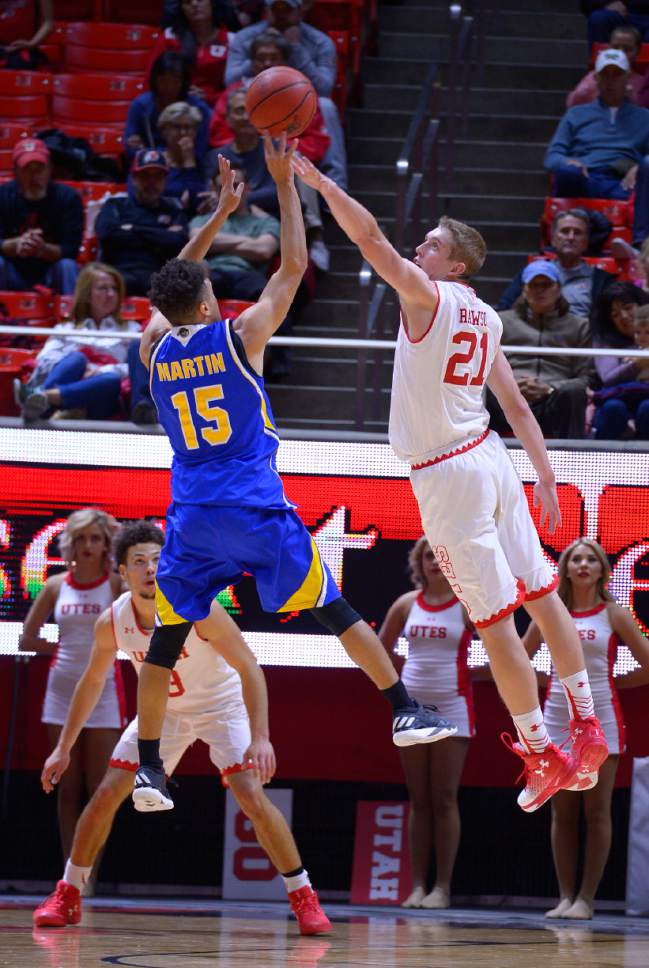This is an archived article that was published on sltrib.com in 2016, and information in the article may be outdated. It is provided only for personal research purposes and may not be reprinted.
In the opening minutes of the NJCAA men's basketball championship game, Todd Phillips saw Tyler Rawson do something he had rarely seen.
The sophomore forward, who led Salt Lake Community College early on, got a steal and drained a 3 against Hutchinson Community College. But what surprised his coach came next: He pressed a finger to his lips, issuing a message to the crowd of roughly 7,000 fans crowded in Hutchinson's home gym in Kansas.
"He's always been a guy that we had to push to be aggressive and assertive," said Phillips, whose SLCC team won the championship that day. "It's amazing to see that growth."
An American Fork native, Rawson has seldom been the star on any team he's played for. That's the case at Utah this season as well, where the 20-year-old 6-foot-10 forward has started two games, and come off the bench for three.
But averaging 9.4 points and 7.4 rebounds per game while leading the team with 13 assists, Rawson has established himself as one of Utah's most important newcomers. Even while playing outside of his natural role at power forward, when he plays center instead next to Kyle Kuzma, the Utes have been pleased with the way Rawson affects games.
A sample sequence from Butler: When Rawson subbed in for the first time, within a minute-and-a-half, he had taken a charge. A minute later, he blocked a shot. While it wasn't his best game — and the Utes would like to see his 3-point shooting improve — he finds ways to influence games beyond scoring.
"I love his game," Utes coach Larry Krystkowiak said. "He can shoot it, he can block shots. I think he might be our best passer. He doesn't do any one thing great, but he does a lot of good things."
Rawson's greatest feat might be playing on scholarship for Utah after being offered a walk-on spot three years ago.
On his own high school team, Rawson wasn't the best prospect: That was Ryan Andrus, a 6-foot-11 center that went on to BYU. But ask folks who watched the Cavemen reach to the state semifinals that year and they'll tell you that Rawson made Andrus better, feeding him in the post, and stretching the defense to take pressure off him.
Rawson said it was Utah assistant Tommy Connor, who watched him at an AAU tournament in Las Vegas, who first suggested that he might be a little too unselfish.
"He said, 'If you keep finding your shot like that, keep developing like that,' " Rawson recalled, "'you'll be a really special player."
Rawson signed with Southern Utah out of high school; Phillips, his AAU coach, said had he waited, he might've had bigger offers. But as a freshman with the Thunderbirds, Rawson struggled through a 10-win season while starting two games. While he averaged 7.4 points and 4.1 rebounds per game in his first year, he thought he was as good as any big man in the Big Sky, and determined he wanted to go elsewhere to develop past that mark.
"I just didn't feel right about it," he said. "I wanted to get better. And going to Salt Lake was the best thing I've ever done."
Rawson called up his old AAU coach Phillips to join the Bruins, and thrived. He enjoyed a third-team All-American season while notching 15.9 points, 8.3 rebounds and 1.4 blocks per game. Phillips played to his strengths, using his passing to break zone defenses and his shooting range to create matchup problems. Phillips said Rawson "got his mojo back."
Utah paid attention.
"There's some similarities between our program and SLCC in the way we run things," Krystkowiak said. "We saw it as a pretty easy transition for Tyler coming to us."
Rawson has had to play a little bigger than his natural position while Utah waits on David Collette to get eligible, but Utah has also touted him as one of the leaders in practice. In a team that is rebuilding, Rawson is the one player on the roster who has won a national championship, which the coaching staff sees as an enormous asset as they attempt to acclimate younger players into their culture.
Rawson, a natural homebody who has enjoyed having his parents in the crowd at every home game so far, is happy he made it. But he said he's determined to keep proving to the Utes he was worth the scholarship offer that it took him years to earn. He's grateful for the journey anyhow.
"It helped me develop into my own player," he said. "It taught me that I can carry my own load."
Twitter: @kylegoon —
Montana State at Utah
P At the Huntsman Center
Tipoff • 7 p.m.
TV • Pac-12 Network
Radio • ESPN 700 AM
Records • Montana State (5-2); Utah (4-1)
Series history • Utah leads, 46-27
Last meeting • Nov. 19, 2011 at Utah; Montana State 70, Utah 64
About the Bobcats • Montana State is led by fourth-year coach Brian Fish, who is a former assistant of Oregon coach Dana Altman. ... The Bobcats are the fourth-most prolific 3-point shooting team in the country, averaging 11.4 made per game. ... At 22.7 points per game, guard Tyler Hall is the 23rd leading scorer in the country, and has the sixth-most 3-pointers per game (3.86).
About the Utes • Utah coach Larry Krystkowiak is one win from his 100th victory in the program, and he is 3-3 against the Bobcats as a coach at Montana and Utah. ... The Utes are ranked No. 3 nationally in field goal percentage defense, allowing opponents to shoot only 31.9 percent. ... Averaging 10.0 rebounds per game, junior forward Kyle Kuzma is the fourth-ranked rebounder in the Pac-12.







